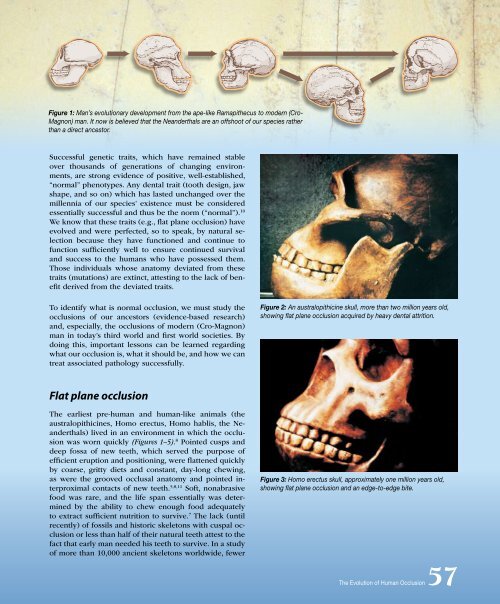PDF Version - Glidewell Dental Labs
PDF Version - Glidewell Dental Labs
PDF Version - Glidewell Dental Labs
Create successful ePaper yourself
Turn your PDF publications into a flip-book with our unique Google optimized e-Paper software.
Figure 1: Man’s evolutionary development from the ape-like Ramapithecus to modern (Cro-<br />
Magnon) man. It now is believed that the Neanderthals are an offshoot of our species rather<br />
than a direct ancestor.<br />
Successful genetic traits, which have remained stable<br />
over thousands of generations of changing environments,<br />
are strong evidence of positive, well-established,<br />
“normal” phenotypes. Any dental trait (tooth design, jaw<br />
shape, and so on) which has lasted unchanged over the<br />
millennia of our species’ existence must be considered<br />
essentially successful and thus be the norm (“normal”). 10<br />
We know that these traits (e.g., flat plane occlusion) have<br />
evolved and were perfected, so to speak, by natural selection<br />
because they have functioned and continue to<br />
function sufficiently well to ensure continued survival<br />
and success to the humans who have possessed them.<br />
Those individuals whose anatomy deviated from these<br />
traits (mutations) are extinct, attesting to the lack of benefit<br />
derived from the deviated traits.<br />
To identify what is normal occlusion, we must study the<br />
occlusions of our ancestors (evidence-based research)<br />
and, especially, the occlusions of modern (Cro-Magnon)<br />
man in today’s third world and first world societies. By<br />
doing this, important lessons can be learned regarding<br />
what our occlusion is, what it should be, and how we can<br />
treat associated pathology successfully.<br />
Figure 2: An australopithicine skull, more than two million years old,<br />
showing flat plane occlusion acquired by heavy dental attrition.<br />
Flat plane occlusion<br />
The earliest pre-human and human-like animals (the<br />
australopithicines, Homo erectus, Homo hablis, the Neanderthals)<br />
lived in an environment in which the occlusion<br />
was worn quickly (Figures 1–5). 8 Pointed cusps and<br />
deep fossa of new teeth, which served the purpose of<br />
efficient eruption and positioning, were flattened quickly<br />
by coarse, gritty diets and constant, day-long chewing,<br />
as were the grooved occlusal anatomy and pointed interproximal<br />
contacts of new teeth. 5,8,11 Soft, nonabrasive<br />
food was rare, and the life span essentially was determined<br />
by the ability to chew enough food adequately<br />
to extract sufficient nutrition to survive. 7 The lack (until<br />
recently) of fossils and historic skeletons with cuspal occlusion<br />
or less than half of their natural teeth attest to the<br />
fact that early man needed his teeth to survive. In a study<br />
of more than 10,000 ancient skeletons worldwide, fewer<br />
Figure 3: Homo erectus skull, approximately one million years old,<br />
showing flat plane occlusion and an edge-to-edge bite.<br />
The Evolution of Human Occlusion57
















